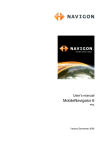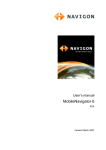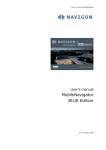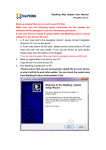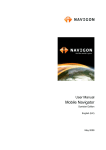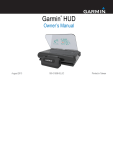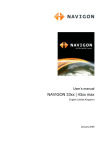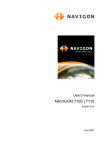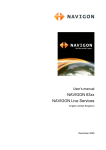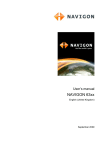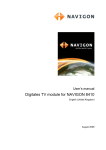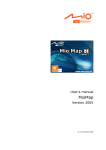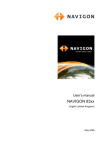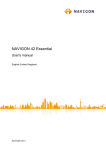Download MN6 PNA - Navigon
Transcript
User’s manual MobileNavigator 6 Version August 2006 Imprint NAVIGON AG Schottmüllerstraße 20A D-20251 Hamburg The information contained herein may be changed at any time without prior notification. This manual nor any parts thereof may not be reproduced for any purpose whatsoever without the express written consent of NAVIGON AG, nor transmitted in any form either electronically or mechanically, including photocopying and recording. All technical specifications, drawings etc are subject to copyright law. © Copyright 2006, NAVIGON AG All rights reserved. User’s manual MobileNavigator 6 Table of contents 1 Introduction 3 1.1 About this manual 3 1.1.1 Conventions 3 1.1.2 Symbols 3 1.2 Legal notice 2 3 Liability 3 1.2.2 Trademarks 4 1.3 Support 4 Before you begin 7 2.1 Software Installation 7 2.2 Navigation with GPS 7 2.3 Important safety information 8 2.3.1 Navigation safety information 8 2.3.2 Safety information on the installation in the vehicle 8 Operating the navigation software 9 3.1 Volume 9 3.2 Information 9 3.3 Software keyboard 10 3.4 Lists 11 3.5 Options 11 3.6 Menus 4 3 1.2.1 12 Navigation 12 4.1 Start MobileNavigator 6 4.1.1 Initialising the GPS receiver 4.2 Specifying a new destination 13 13 14 4.2.1 Specify destination country 14 4.2.2 Address of destination 15 4.2.3 Special destination 15 4.2.4 Information about the destination 18 4.2.5 Quick Access Points of Interest 18 4.3 Select a stored destination User’s manual 19 Table of contents I User’s manual MobileNavigator 6 5 6 4.3.1 Last destinations 19 4.3.2 Favourites 20 4.4 Navigation homewards 20 4.5 Determine the destination on the map 21 4.6 Starting navigation 21 Destination management 22 5.1.1 Saving a destination 22 5.1.2 Define destination as home address 23 Routes with various stages 6.1 Itinerary 23 23 6.1.1 Enter the starting point 23 6.1.2 Enter route stages 24 6.1.3 Edit route stages 25 6.2 Managing routes 25 6.2.1 Save route 25 6.2.2 Load route 26 6.3 Navigation 26 6.3.1 Calculate and display the route 26 6.3.2 Simulating the route 26 6.3.3 Starting navigation 27 7 Options 28 8 Working with the map 30 8.1 Maps 30 8.2 Map in Preview mode 31 8.3 Map in Navigation mode 32 8.4 Map in Destination search mode 35 8.4.1 9 Working in Destination search mode Useful functions 36 37 9.1 GPS status, store current location 37 9.2 TMC (Traffic information) 38 9.3 TMC Settings 38 10 Configuring MobileNavigator 6 39 11 Index 41 II Table of contents User’s manual User’s manual MobileNavigator 6 1 Introduction 1.1 About this manual 1.1.1 Conventions For better legibility and clarification, the following styles are used in this manual: Bold and italics: Registered names, company and product descriptions. SMALL CAPITALS: Window and dialogue box titles. Bold: Highlighting important parts in the text. Underlined: Descriptions of buttons, input fields and other elements in the user interface. 1.1.2 Symbols The following symbols refer to specific passages of text: Instructions and tips for operating the software Further detailed information and explanations Warnings 1.2 Legal notice 1.2.1 Liability The software and documentation are subject to change without notice. NAVIGON AG is not liable for the accuracy of the information contained in this manual or for damages resulting from the use of this manual. To improve the quality of our products and our services, we appreciate all suggestions for improvement and all error notices. Introduction -3- User’s manual MobileNavigator 6 1.2.2 Trademarks All brands and trademarks mentioned in this document are possibly registered by third parties and are subject to the current legislation and to the rights of their respective owners without reservation. All mentioned names of products, societies, or brands may be registered trademarks of their respective owners. Every right that is not explicitly accorded is reserved. The absence of an explicit labelling of registered trademarks does not allow the conclusion that this brand was not subject to the rights of third party. 1.3 ▶ Windows and ActiveSync are trademarks of the Microsoft Corporation. ▶ NAVIGON is a registered trademark of NAVIGON AG. Support Our service team employees are available via telephone or Email in many countries. You can find additional information at the NAVIGON AG Website under (www.navigon.com) in the "Service & Support" section. Telephone Support Note: All quoted costs refer to calls made from a landline within the relevant country. Germany Telephone: 01805-6284466 Service times: Monday to Saturday from 8 to 20 hrs MEZ Costs: 0.12 €/min. Belgium Telephone: 0900-70016 Service times: Monday to Friday from 8 to 20 hrs MEZ Costs: 0.45 €/min. + 0.05 €/ per call -4- Introduction User’s manual MobileNavigator 6 Denmark Telephone: 901-31033 Service times: Monday to Friday from 8 to 20 hrs MEZ Costs: 3.00 DKK/min. Finland Telephone: 0600-413414 Service times: Monday to Friday from 8 to 20 hrs MEZ Costs: 0.50 €/min. France Telephone: 0891-650065 Service times: Monday to Saturday from 8 to 20 hrs MEZ Costs: 0.225 €/min. Great Britain Telephone: 0905-8480701 Service times: Monday to Friday from 8 to 20 hrs MEZ Costs: 0.25 GBP/min. Italy Telephone: 166-205301 Service times: Monday to Friday from 8 to 20 hrs MEZ Costs: 0.40 €/min. + 0.09 €/ per call Netherlands Telephone: 0900-0400468 Service times: Monday to Friday from 8 to 20 hrs MEZ Costs: 0.30 €/min. + 0.045 €/ per call Norway Telephone: 820-33050 Service times: Monday to Friday from 8 to 20 hrs MEZ Costs: 3.26 NOK/min. Austria Telephone: 0820-240437 Service times: Monday to Friday from 8 to 20 hrs MEZ Costs: 0.145 €/min. Introduction -5- User’s manual MobileNavigator 6 Sweden Telephone: 0900-1001110 Service times: Monday to Friday from 8 to 20 hrs MEZ Costs: 4.00 SEK/min. Switzerland Telephone: 0848-662544 Service times: Monday to Friday Costs: 08 - 17 hrs: 0.11 17 - 22 hrs: 0.09 22 - 08 hrs: 0.06 from 8 to 20 hrs MEZ CHF/min. CHF/min. CHF/min. Spain Telephone: 807-001205 Service times: Monday to Friday from 8 to 20 hrs MEZ Costs: 08 - 20 hrs: 0.356 €/min. + 0.104 €/ per call 20 - 08 hrs: 0.288 €/min. + 0.104 €/ per call USA Telephone: +1-888-8480701 Service times: Monday to Friday from 8 to 20 hrs MEZ Cost: free of charge Other countries Telephone: +43-820-8888-10 Service times: Monday to Friday from 8 to 20 hrs MEZ Costs: dependent on telephone provider Support via Email Danish: German: English: Finish: French: Italian: Dutch: Norwegian: Swedish: Spanish: -6- [email protected] [email protected] [email protected] [email protected] [email protected] [email protected] [email protected] [email protected] [email protected] [email protected] Introduction User’s manual MobileNavigator 6 2 Before you begin 2.1 Software Installation 1. Insert the memory card into your device. Note: The memory card must remain in the device during operation of the navigation system. 2. Slide the main switch on the under side of the device to the ON position. The installation will now be carried out. 2.2 Navigation with GPS GPS is based on a total of 24 satellites that circle the earth and, in doing so, are constantly transmitting their position and the current time. The GPS receiver receives this data and calculates its own geographical position on the basis of the information broadcast by the various satellites. For a sufficiently precise positioning it is necessary to obtain the data from at least three satellites. With the data from 4 or more satellites the altitude above sea level can also be ascertained. The determination has an accuracy of about 3 yards. Once MobileNavigator 6 has determined your position, this position can be used as a starting point for a route calculation. The map data on your navigation device includes the geographical coordinates of all digitally recorded points of interest, streets and places. From this the server can calculate a route from any given starting point to a destination. The calculation of the current position and its representation on the map takes place once every second. So your current position is always shown on the map. Before you begin -7- User’s manual MobileNavigator 6 2.3 Important safety information In your own interest, read the following notices and safety information carefully before starting up your navigation system. 2.3.1 Navigation safety information The usage of the navigation system is at your own risk. Caution! To prevent accidents, do not program the navigation system while driving. Caution! Do not look at the display unless it is absolutely safe to do so! Caution! Traffic regulations have priority over any instructions from the navigation system. Caution! Only follow the instructions of the navigation system when the circumstances and the road traffic regulations allow doing so. The navigation system will guide you to your destination even if you deviate from your calculated route. Note: If you have not understood the instructions or your'e not sure about what to do next you may refer briefly to the map or arrow view of your navigation system. 2.3.2 Safety information on the installation in the vehicle Caution! Make sure you do not attach the cradle for the mobile telephone or for the GPS receiver in the danger zone of the airbag. Caution! When installing the cradle, ensure that it does not represent a risk in the event of an accident. -8- Before you begin User’s manual MobileNavigator 6 3 Operating the navigation software 3.1 Volume The volume of the spoken driving instructions from MobileNavigator 6 can be adjusted during the navigation. You have started a navigation. The map is in Navigation or Destination search mode. 1. Tap the button Volume. The volume bar opens. It contains three buttons for adjusting the volume. Louder, Quieter, 2. Tap the Volume Sound on/off. button again. The volume bar closes. 3.2 Information Symbols located at the top of the screen are used to display information. GPS The GPS symbol can show the following GPS-reception status: No GPS The built-in GPS reciever is not operational. Consult customer service if the problem persists. No Signal Data is being received from less than three satellites. The position cannot be calculated. GPS ready Data is being received from at least three satellites. The position can be calculated. Refer to chapter "GPS status" on page 37 for detailed information regarding the GPS status. Operating the navigation software -9- User’s manual MobileNavigator 6 Energy The Energy symbol can display the following states of the built—in battery: The device is being supplied by an external power source. The battery is being charged. The device is being supplied by its internal battery. The battery charge is sufficient. The device is being supplied by its internal battery. The battery charge is low. Direction The Direction symbol shows you in which direction you are currently moving. It can show the following points of the compass: N, NE, E, SE, S, SW, W, NW TMC (Traffic information) The TMC symbol can display the following TCM states: No Symbol THe built-in TCM receiver is not operational. Contact customer service if the problem persists. Tuning: The TMC receiver is operational but cannot find a transmitter that is sending TCM signals. TMC on Standby: Traffic messages can be receiverd. For details of the TMC functions please refer to chapter "TMC (Traffic information)" on page 38. 3.3 Software keyboard A software keyboard appears at the bottom of the screen when text entries are necessary. All entries can be made on the software keyboard using the fingertips. All entries can be made on the software keyboard using the fingertips. Only capital letters can be entered. When entering town or street names you must not enter any special characters or umlauts. MobileNavigator 6 replaces these characters automatically. If, for example, you are - 10 - Operating the navigation software User’s manual MobileNavigator 6 searching for “Würzburg”, then simply enter "WURZBURG". You need not enter special characters when entering a destination's town or street name but they may be helpful for entering names for saved destinations and itineraries. Special keys Enters a space character. deletes the character to the left of the cursor. opens the numeric keypad. opens the character keyboard. opens the special character keyboard. As soon as you have entered a special character the letter keyboard reappears. 3.4 Lists There are many cases where you have to select an entry from a list. This is the case, for example, when you enter a location. As soon as you enter the first letter, the largest city in the given country that begins with this letter appears. As soon as you enter the second letter, a list appears with all locations that begin with the given letters. If you enter additional letters, the list adapts to your entries. It only contains entries that begin with the text that has been entered or contain the text in the name. The more letters you enter, the shorter the list will become. You can move around in the list by means of the Up and Down buttons. Tap on an entry in the list to confirm it. The list will close as soon as you have confirmed an entry. 3.5 Options Some windows have options which lead to further functions. Operating the navigation software - 11 - User’s manual MobileNavigator 6 For detailed information on the options, please refer to the Options chapter on page 28. 3.6 Menus Some buttons have menus which open when activated. Tap on a menu button to select its function. If you would like to quit the options list without selecting an option, tap on the button which you used to open the menu. 4 Navigation Use navigation system at your own risk. Caution! Please be sure to refer to the safety information in the "Important safety information" chapter on page 8. Obstructed GPS reception If GPS reception is hindered, navigation will be interrupted. The navigation sofware remains open. As soon as GPS reception is restored, the navigation system registers any change of position since the last signal received. You may simply continue navigation. Arriving at your destination When you have reached the specified destination, a message to this effect will be displayed. Only your current position (triangle in orange) will now be shown on the map. Quit MobileNavigator 6 If you would like to quit the navigation software, go to the MAIN WINDOW and tap the - 12 - (Quit) button. Navigation User’s manual MobileNavigator 6 4.1 Start MobileNavigator 6 1. Switch the navigation device on. 2. Tap on the navigation software symbol. Each time you start the navigation software , the following message will appear: Please note that the road traffic regulations are prior to the instructions of the navigation system. Please do not operate the device while driving. 3. After you have read and fully understood the text, tap on the button OK. 4. If you do not wish to confirm this information then tap on the Cancel button in order to quit the navigation software. The Main Window opens. You can reach any of the navigation software functions via the MAIN WINDOW. 4.1.1 Initialising the GPS receiver Note: It can take up to 20 minutes to initialise the GPS receiver for the first time. Each time you switch on the receiver after this, the GPS reception will start within one minute.. If the navigation device has been switched off for more than a week, the next initialisation can take up to 10 minutes. As soon as the navigation device has been switched on, initialisation of the GPS-receiver will begin. In the right-hand top corner of the display, you will see the GPS symbol. As soon as data from at least 3 satellites is received, the symbol changes to GPS ready. Note: If the GPS symbol displays GPS ready after considerably less than 20 minutes, then it is best to switch off the receiver for at least 15 minutes so as to guarantee reliable operation of the receiver. Caution! If you have connected the navigation device to the power supply using a cigarette lighter, remove the connector before you leave the vehicle standing for a long period of time. As the GPS receiver requires a constant power supply, it could run down the vehicle´s battery. Navigation - 13 - User’s manual MobileNavigator 6 Opening the Main window The MAIN WINDOW opens when the navigation software starts. If another window is open, tap the previous window will open. Tap repeatedly on the opens. (Back) button. The (Back) button until the MAIN WINDOW 4.2 Specifying a new destination New destinations for MobileNavigator 6 are all destinations that you have not yet navigated, or you have not yet stored. You can enter an address here, select a special destination, or select a destination from the quick search function. If you are entering a new destination for the first time, the COVERED COUNTRIES list opens. Tap on the country, in which your destination lies. 4.2.1 Specify destination country Above the right-hand upper corner of the uppermost entry field of the window ADDRESS, POI IN A CITY, and POI OF NATIONAL SIGNIFICANCE, is the Country button. It shows the country code of the country from which current navigation destinations can be entered. If your destination is in a different country, then proceed as follows: 1. Tap on the Country button. The COVERED COUNTRIES list opens. 2. Tap on the country in which your destination lies. The COVERED COUNTRIES list closes again. The symbol will display the country code of the destination country. Note: Only countries of which at least a part is represented on the currently loaded map may be selected. - 14 - Navigation User’s manual MobileNavigator 6 4.2.2 Address of destination 1. In the MAIN WINDOW, tap on New destination > Enter an address. The ADDRESS window opens. 2. Enter the name of the town or the postcode. 3. Enter the name of the street. You can also enter the name of a well-known building, e.g. "Olympic stadium" or "Eiffel tower". 4. Enter the number of the house. If you don't know the number of the house, or you specified an object in the preceding step, then leave the field empty. If you don't know the house number, but know the name of a nearby side street, then tap on the Intersection field and enter the name of the street. The navigation system will calculate a route to the intersection of the streets you have specified. Note: It is not necessary to enter all the address details. If you specify the town only, the navigation system will calculate a route to the town centre. If you specify the town and street, without specifying a house number or side street, the navigation system will calculate a route to the centre of the street entered. 5. Tap on the Start navigation button. The map screen opens in Preview mode. Note: For detailed information on how to start the navigation system, please refer to chapter "Starting navigation" page 21. 4.2.3 Special destination Special destinations, also known as to POIs (Points Of Interest) are useful addresses that are catalogued according to particular criteria. Ports, airports, restaurants, hotels, petrol stations, public buildings, and others belong to the special destinations. Points of interest can be displayed on the map by means of a symbol. Tap on Options > Settings > POI in the MAIN WINDOW in order to select which categories are to be displayed on the map. Navigation - 15 - User’s manual MobileNavigator 6 Special destinations nearby Special destinations nearby are special destinations that are located within a particular radius of your current location.. This means you can always find, for example, the nearest petrol station, no matter where you are. Note: The GPS-reception must be sufficient for position determination. You can see if GPS-reception is sufficient by (GPS ready) symbol. For further looking at the information, please refer to chapter "GPS status" on page 37. Note: In quick access mode, there are three categories of special destinations available from the current vicinity, which can be searched quickly and without additional entry. For detailed information, please refer to chapter "Quick Access Points of Interest" on page 18. 1. In the MAIN WINDOW, tap on New destination >Search for POI > nearby. The POI NEARBY window opens. 2. Tap a category from which you would like to select a Point of Interest. If sub-categories exist for the category you have selected, the Sub category list will open. 3. Tap a sub-category from which you would like to select a Point of Interest. The Name of the destination list opens. It contains the nearest special destinations in the given category, sorted by distance. 4. Tap on the name of the destination. 5. Tap on the Start navigation button. The map screen opens in Preview mode. For detailed information on how to start the navigation system, please refer to chapter "Starting navigation" on page 21. - 16 - Navigation User’s manual MobileNavigator 6 Nationwide Points of Interest Nationwide Points of Interest are airports, places of interest, national monuments, large ports etc. This enables you to find places of interest without having to know the name of the location.This enables you to find places of interest without having to know the name of the location. 1. In the MAIN WINDOW, tap on New destination > Search for POI > nationwide. The POI OF NATIONAL SIGNIFICANCE window opens. 2. Tap a category from which you would like to select a Point of Interest. The Name of the destination list opens. It contains the nearest special destinations in the specified category, sorted by distance. 3. Tap on the name of the destination. 4. Tap on the Start navigation button. The map screen opens in Preview mode. For detailed information on how to start the navigation system, please refer to chapter "Starting navigation" on page 21. Point of Interest in a given location Points of Interest in a given location can be useful when navigating in an unfamiliar town. 1. In the MAIN WINDOW, tap on New destination > Search for POI > in a city. The POI IN A CITY window opens. 2. Enter the name of the town or the postcode. 3. Tap a category from which you would like to select a Point of Interest. If sub-categories exist for the category you have selected, the Sub category list will open. 4. Tap a sub-category from which you would like to select a Point of Interest. The Name of the destination list opens. It contains the special destinations from the specified category, sorted alphabetically. Navigation - 17 - User’s manual MobileNavigator 6 5. Tap on the name of the destination. 6. Tap on the Start navigation button. The map screen opens in Preview mode. For detailed information on how to start the navigation system, please refer to chapter "Starting navigation" on page 21. 4.2.4 Information about the destination For many destinations that you specify, there will be further information available stored in the navigation system's database. For example, for many restaurants, there is a telephone number available. You can then phone up in order to reserve a table, for example. One of the destination entry windows described is open. Tap the (Destination info) button. The DESTINATION INFO window opens. It contains all information about the specified destination that is stored in the navigation system's database. 4.2.5 ▶ Tap on the (Show on map) button, in order to show the destination on the map. ▶ Tap the Cancel button to close the DESTINATION INFO window. Quick Access Points of Interest The quick access system contains three categories of special destinations. Destinations in your vicinity that correspond to these categories can be listed quickly, without the need for additional entry. In the Main Window, tip on Options > Settings > POI in order to set which categories are available in the quick access system. - 18 - Navigation User’s manual MobileNavigator 6 Note: The GPS reception must be sufficient for position determination. You can see if GPS-reception is sufficient by (GPS ready) symbol. For detailed looking at the information, please refer to chapter "GPS status" on page 37. 1. In the MAIN WINDOW, tap the New destination button. The NEW DESTINATION menu opens. The symbols of the categories which have been selected for quick access can be seen in the menu at the bottom. 2. Tap a category from which you would like to select a Point of Interest. The Name of the destination list opens. It contains the nearest points of interest in the specified category, sorted by distance. 3. Tip on the name of the destination. The map screen opens in Preview mode. For detailed information on how to start the navigation system, please refer to chapter "Starting navigation" page 21. 4.3 Select a stored destination The following lists of destinations and addresses are available for selection from My destinations in MobileNavigator 6. 4.3.1 ▶ LAST DESTINATIONS: destinations that you have previously navigated. ▶ FAVOURITES: all destinations that you have stored in MobileNavigator 6. Last destinations MobileNavigator 6 saves the last 100 destinations to which you have navigated, in the LAST DESTINATIONS list. 1. In the MAIN WINDOW, tap on My destinations > Last destinations. 2. Tap the destination to which you would like to navigate. 3. Tap the Start navigation button. The map screen opens in Preview mode. Navigation - 19 - User’s manual MobileNavigator 6 For detailed information on how to start the navigation system, please refer to chapter "Starting navigation" page 21. 4.3.2 Favourites Preferred destinations can be saved in the FAVOURITES list. In the FAVOURITES list, up to 300 destinations can be saved. Information on how to store a destination can be found in the "Saving a destination" chapter on page 22. 1. In the MAIN WINDOW, tap on My destinations > Favourites. 2. Tap the destination to which you would like to navigate. 3. Tap Start navigation. The map screen opens in Preview mode. For detailed information on how to start the navigation system, please refer to chapter "Starting navigation" page 21. 4.4 Navigation homewards In MobileNavigator 6 you can save your address as Home Address. You can navigate to your Home Address by tapping a single button. The first time you tap the Take me home button, you will be requested to enter your address. Further information about entering your home address can be found in chapter "Define destination as home address" page 23. 1. In the MAIN WINDOW, tap the Take me home button. If you have not entered an address, a pop-up window will notify you. The navigation starts. The route profile of the previous navigation applies. - 20 - Navigation User’s manual MobileNavigator 6 4.5 Determine the destination on the map You may indicate a destination directly on the map. In addition to towns and streets, you may also select special destinations quickly. 1. In the MAIN WINDOW, tap on Options > Show Map. The map screen opens in Destination search mode. 2. Tap the destination to which you would like to navigate. Note: Please refer to chapter "Map in Destination search mode" on page "35" for information about how to change the map view so that your destination can easily be seen. The destination that you have selected appears under the cross hairs. The geographical coordinates of the destination and the corresponding address is shown in the bottom third of the screen. 3. Tap the (OK) button. The DESTINATION ON MAP window opens. The detailed address data of the selected destination are displayed in the left-hand upper corner. 4. Tap Take me there. The map screen opens in Preview mode. For detailed information on how to start the navigation system, please refer to chapter "Starting navigation" page 21. 4.6 Starting navigation The map is open in Preview mode. The navigation destination is depicted by a small flag. The route and the estimated trip time is displayed. A so called route profile forms the basis of the route calculation. Tap the Route profile button if you don't want to view or change the route profile. Navigation - 21 - User’s manual MobileNavigator 6 Note: If you change the route options, any changes made also remain valid for subsequent navigations. You can get information regarding the individual route profile (Help) button. settings by clicking on the corresponding 5. Tap the Start navigation button or just start driving. No GPS reception When the received GPS signal is not sufficient, the following message appears: "No GPS signal available at present. Would you like to use the last known position?" You have the following possibilities: 5 ▶ Tap OK. The route will be calculated with the last known position as starting point. As soon as the GPS reception is sufficient for position determination, the route will be recalculated and you can begin the navigation. ▶ Tap Cancel. The MAIN WINDOW opens. The destination is now saved to the LAST DESTINATIONS list. Destination management Every destination that you enter and the destinations from the LAST DESTINATIONS list may be added to the FAVOURITES list. This makes sense if you frequently navigate to a respective destination. 5.1.1 Saving a destination 1. Enter a destination as described in "Specifying a new destination" on page 14. Do not tap on the Start navigation button! 2. Tap .Options > Save destination. - OR – 1. Enter a destination as described in "LAST DESTINATIONS", page 19. Don't tap the Start navigation button! 2. Tap Options > Save as favourite. 3. Enter a name for the destination. - 22 - Destination management User’s manual MobileNavigator 6 4. If you want to define the destination as your home address, tap on the button value is highlighted in black. (Toggle), so that the Yes 5. Tap Save. 5.1.2 Define destination as home address You can define precisely one destination from the FAVOURITES list as your home address. You can then begin navigation to this destination very quickly by tapping the Take me home button in the MAIN WINDOW. 1. Select the destination which you want to define as your home address from the FAVOURITES list. (See "Favourites", page 20) 2. Tap Options > Home address. The selected destination has now been saved as your home address. Your home address now appears in the FAVOURITES list together with a house symbol. 6 Routes with various stages You may plan itineraries without receiving GPS-signals, e.g. comfortably at home. Planned itineraries may be stored. Thus you may plan as many itineraries as you want, e.g. for holidays. 6.1 Itinerary 1. In the MAIN WINDOW, tap the Options button. The options list opens. 2. Tap the Route planning option. The ROUTE PLANNING window opens. 6.1.1 Enter the starting point The starting point of a route is the point at which you want to begin your trip. This must not necessarily be the current location. If you want to plan a route for a trip on your holidays, you could, for example, enter your hotel as the starting point. Routes with various stages - 23 - User’s manual MobileNavigator 6 The starting point is only important if you want to see a planned route on the map, but currently have no GPS reception or you are not currently at the planned starting point. The starting point that you enter therefore has the flow number "0". As soon as you begin a navigation, your current location will be used as the basis for the route calculation. The first stage is therefore the trip to the route stage with the flow number "1". 1. Tap on the field Specify starting point. The STARTING POINT menu opens up. If you want to enter your current location as the starting point: 2. Tap on the menu point Current position. If you want to enter a different starting point: 2 Tap on the corresponding button. 3. Enter the starting point according to the relevant section in chapter "Navigation" on page 12. 4. Tap the button Set starting point. The selected starting point will now be shown next to button O (Starting point). Change the starting point Tap Specify starting point. The STARTING POINT menu opens. You can now enter a different starting point. Proceed as described above. 6.1.2 Enter route stages Route stages are points within the route that you want to navigate to. In front of every route stage is its flow number on a button. 1. Tap on the field Specify route point. The ROUTE POINT menu opens. 2. Tap on the button for the desired destination entry type. 3. Enter the route stage. (See the corresponding section of chapter Navigation on page 12). 4. Tap Add. - 24 - Routes with various stages User’s manual MobileNavigator 6 The selected route stage will now be shown next to its flow number. Repeat this step for each additional destination that you want to add to your route. 6.1.3 Edit route stages Route stages can be deleted from a route. The order of the route stages can be varied as you wish. Note: The start point (flow number "0") can neither be moved or deleted. ▶ Tap on the route stage that you want to edit. The context menu contains the following buttons: Route point up: Moves the selected route stage forwards (example: route stage 2 becomes route stage 1) Route point down: Moves the selected route stage back. (Example route stage 2 becomes route stage 3). Delete: Deletes the selected route stage. A dialog window will prompt you to confirm the deletion. 6.2 Managing routes You can save each planned route under a particular name. Note: Only the route starting points and the route stages will be saved, not the calculated route. If you load a route, you will have to recalculate it before navigation begins. You can load, rename or delete stored routes. 6.2.1 Save route The ROUTE PLANNING window is open. You have entered the starting point and at least one route stage. 1. Tap on Options > Save route. 2. Enter a name for the route. Routes with various stages - 25 - User’s manual MobileNavigator 6 3. Tap Save. The destination is now entered into the SAVED ROUTES list. The dialog window closes. 6.2.2 Load route 1. Tap Options > Saved routes. 2. Tap the route that you want to load. 3. Tap the Load route button. The ROUTE PLANNING window opens. The starting point and the route stages of the loaded route are entered. 6.3 Navigation The system first has to calculate the route. Afterwards, you can begin the navigation or just simulate it. 6.3.1 Calculate and display the route A route may be calculated and displayed on the map even without GPS reception in order to get an impression on the itinerary. The ROUTE PLANNING window is open. The starting point and at least one stage has been entered. 1. Tap the Show route button. The map screen opens in Preview mode. The starting point and the route stages are marked by flags. For each stage, the distance and the estimated trip time is given. These data are also given for the entire trip. 6.3.2 Simulating the route You can also just simulate a navigation. Note: The reception of GPS-signals is not necessary for the simulation. Simulation is restricted to routes of 60 mi max. You have calculated and displayed a route. 2. Tap Options > Simulation. The route will be recalculated for simulation purposes. Simulation starts when calculation has finished. - 26 - Routes with various stages User’s manual MobileNavigator 6 End simulation You may stop a simulation at any moment. 1. Tap the (Back) button. A dialog box will prompt you to confirm the navigation cancel. Afterwards, the MAIN WINDOW opens. 6.3.3 Starting navigation You have calculated and displayed a route. The calculation of a route is based on so called route options. 1. If you want to view or change these options, click on the Route profile button. Note: If you change the route options, these remain valid for subsequent navigations. You can get information regarding changing individual route profiles by tapping the corresponding Help buttons. 2. Tap the Start navigation button or simply start driving. No GPS reception When the received GPS signal is not sufficient, the following message appears: "No GPS signal available at present. Would you like to use the last known position?" You have the following possibilities: ▶ Tap OK. The route will be calculated using the last known position as the starting point. As soon as the GPS reception is sufficient for determining the position, the route will be re-calculated and you can begin the navigation. ▶ Tap the Cancel button. The MAIN WINDOW opens. The destination is now saved to the LAST DESTINATIONS list. Routes with various stages - 27 - User’s manual MobileNavigator 6 7 Options Some windows have options which lead to further functions. ▶ Tap on the Options button to open the options list. ▶ Tap on the options you would like to implement. ▶ If you would like to quit the options list without selecting an option, tap on the Options button again. Delete all Deletes all destinations from the LAST DESTINATIONS list. The list is then empty. A dialog box prompts you to confirm. Save as favourite Saves the given destination to the FAVOURITES list. For detailed information, please refer to chapter Saving a destination page 22. Show on map Shows the given address on the map. Settings Opens the SETTINGS window. Here you can configure the navigation system. For detailed information, please refer to chapter Configuring MobileNavigator 6 on page 39. Saved routes Opens a dialog window with which you can load a stored route. GPS status Opens the GPS STATUS window. Here you can see details regarding GPS reception. You can also save data regarding your current location. For detailed information, please refer to chapter GPS status page 37. Home address Saves the selected destination your home address. You can then begin navigation to this destination very quickly by tapping the Take me home button in the Main Window. - 28 - Options User’s manual MobileNavigator 6 Calibration Opens a window in which you can re-calibrate the touchscreen (re-align), should it become imprecise to the touch. Show Map The map screen opens in Destination search mode. Here you can determine your navigation destination directly on the map. For detailed information, please refer to Determine the destination on the map chapter page 21. Delete Deletes the selected destination from the FAVOURITES list. A dialog box prompts you to confirm. New route Deletes the starting point and all route stages from the ROUTE window, so that you can plan a new route. PLANNING If necessary, save the previously planned route! Product info Opens a window in which you can obtain information regarding the iinstalled software. You can also see the navigation system's clock. Save route Opens a window in which you can save the planned route under a particular name. For detailed information, please refer to chapter Save route on page 25. Route planning Opens the ROUTE PLANNING window. Here you can plan routes, administer planned routes and start navigating to a planned route. For detailed information, please refer to chapter Routes with various stages page 23. Route profile Opens the ROUTE PROFILE window. Here you can view the options for route planning and, if necessary, change them. Options - 29 - User’s manual MobileNavigator 6 Simulation Simulates a navigation based on the displayed route. This simulation can be undertaken without GPS reception. However, simulation is restricted to routes of 60 mi max. Traffic Opens the TRAFFIC INFORMATION window, in which pending reports can be listed. For detailed information, please refer to chapter TMC (Traffic information) on page 38. Rename Opens a window in which you can change the name for the selected destination or route. Factory settings Opens a window in which you can reset all settings to the original factory settings. Delete destination Seletes the marked destination from the (LAST DESTINATIONS or FAVOURITES) lists. A dialog box prompts you to confirm. Save destination Saves the given address in the FAVOURITES list. For detailed information, please refer to chapter Saving a destination on page 22. Add to route Opens the route planning system. The address entered will be entered as the first route stage of a new route. For detailed information, please refer to chapter Routes with various stages on page 23. 8 Working with the map 8.1 Maps Even if you have stored numerous navigation maps on the navigation system's memory card, MobileNavigator 6 can only work with one map at a time. Tap on Options > Settings > Current map, in order to see which map is currently being used. You can also select another map. - 30 - Working with the map User’s manual MobileNavigator 6 8.2 Map in Preview mode You have entered a destination and tapped on the Start navigation button. - OR – You have planed or loaded a route and tapped the Show route button. The map screen opens in Preview mode. You can see the entire route. 1 The destination is marked with a little flag. When you have planned or loaded a route and displayed it, the starting points and each route stage will be marked with a little flag. 2 3 The route is marked in orange. A triangle in orange shows the current position. If you display a planned or loaded route and the given starting point is not the same as your current location, then the current position may not be shown on the preview. 4 You will see the entire route in a small info box, together with the estimated trip time and the estimated time or arrival. This information can be displayed or hidden by means of Options > Settings > Basic settings. Working with the map - 31 - User’s manual MobileNavigator 6 If you display a route with various stages, you will see this information for each stage. ▶ Tap the Route profile button, in order to view or change the profile on which the route calculation is based. ▶ Tap on the Start navigation button in order to begin the trip. When you display a planned or loaded route, the route may be re-calculated. Your current location will be integrated into the calculation. The navigation will initially guide you to the first route stage entered. ▶ 8.3 Tap on (Destination search), in order to view the map in Destination search mode. (see "Map in Destination search mode", page 35) Map in Navigation mode After the route has been viewed in Preview mode, the navigation has been started. The map screen opens in Navigation mode. 1 Here is shown what signposts should be followed. 2 Possible speed limits may be shown here. - 32 - Working with the map User’s manual MobileNavigator 6 3 4 If two manoeuvres need to be executed quickly one after the other, the small arrow field indicates the manoeuvre to be executed immediately after the next manoeuvre. The large arrow field shows a diagram of the next junction which you should turn on to. Underneath is the distance to the next junction. When you approach the junction, you will see a spot diagram instead of the distance. The nearer you are to the junction, the fewer yellow spots are displayed. If you don't have to change direction for a longer period, you will only see a forward-facing arrow with the distance shown underneath, which shows how long you are to follow the current road. 5 6 7 8 9 10 The route is depicted in the colour orange. A triangle in orange shows the current position on the map. The displayed sector of the map changes continually to show your current position centred on the map whenever possible. The height above sea level and the current speed is shown here. In the Total field you can see the entire route, the estimated trip duration and the estimated time of arrival. If you navigate a route with various stages, you will see the route, the estimated trip duration and the estimated time of arrival in the Next field. The traffic lanes that lead to your destination are depicted in the colour orange. Working with the map - 33 - User’s manual MobileNavigator 6 11 12 The name of the route section that you need to drive onto next is shown in the upper street field. The name of the street you are currently driving on is shown in the lower street field. Note: The displays for many of the above mentioned areas can be configured via Options > Settings > Basic settings. A number of displays only work when the corresponding information is available on the map. Note: If you tap on the large arrow field, then the current route instruction will be repeated. Tap the (Destination search) in order to view the map in Destination search mode (See Map in Destination search mode on page 35). Quit navigation Tap (Back), in order to end the navigation. A dialog box prompts you to confirm. Map functions in Navigation mode When the map is open in the Navigation mode, tap any point on the map. Various buttons with options will be displayed. 2D/3D: Changes between 2D and 3D mode. The symbol of the currently set mode is shown in orange. Day/Night: changes the display mode between "day" and "night". The symbol of the mode currently set is displayed in orange. Interim destination: Opens the menu for entering a way point. The navigation will then guide you to this way point. Then you can simply continue navigation to your original destination. Skip route point: Tap this icon to omit the next stage from the list. This button is inactive when less than 2 stages are pending. Block: Tap this button in order to block a stage, i.e. to re-calculate the route to avoid the stage, e.g. if you have heard of a traffic jam relating to this section on the radio. - 34 - Working with the map User’s manual MobileNavigator 6 Tap on this button once, in order to remove the block. POI on your route: Tap this button to display the special destinations on your route. This enables you to find out, for example, how long you need or how far it is to the nearest services. You can also add a destination shown here as a way point by tapping (Interim destination) to the right, next to its entry in the list. 8.4 Map in Destination search mode The map is always in Destination search mode, when a pair of cross hairs are to be seen. When you are driving, the map does not change direction. It is always oriented with north shown at the top. Zoom out: The map section shown becomes larger, but you will see fewer details. Zoom in: The map section becomes smaller, but you will see more details. Zoom mode: When this button is active, you can draw a map section with the pen or your finger. Working with the map - 35 - User’s manual MobileNavigator 6 Draw the map section from upper left to bottom right. and it will then zoom to fit the screen size. Draw the map section from bottom right to top left, and the map will zoom out. Pan mode: When this button is active, you can change the map section with the pen or with your finger. Simply push the map in the desired direction. Entire route: Zooms the map so that the entire route is visible. Current position: Selects the map section shown, so that the current location is centred. 8.4.1 Working in Destination search mode 1. Tap on the point to which you wish to navigate. The destination that you have selected appears under the cross hairs. The geographical coordinates of the destination and the corresponding address is shown in the bottom third of the screen. 2. Tap the (OK) button. Buttons with various functions will appear. Take me there: Begins the navigation to the selected point. If you are currently in a navigation, it will be aborted. Interim destination: Sets the selected point as way point. The navigation system will then guide you to this way point first. Afterwards, you can simply continue your original navigation. This function is only active when you are currently in a navigation. Set as destination: Adds the selected point as the last point in the route plan. If no route plan has been opened, the selected point will become the first point in a new route plan. - 36 - Working with the map User’s manual MobileNavigator 6 Save: Opens the SAVE DESTINATION AS... window. You can enter a name, under which the selected point will be stored in the FAVOURITES list. For detailed information, please refer to chapter "Saving a destination" on page 22. Neighbourhood search: Opens the POI NEARBY.window. Here you can search for destinations near the selected point. See "Special destinations nearby", on page 16). Tap (Destination search), in order to quit Destination search mode. You will be returned to the window from which you started this mode. (Back), in order to return to the MAIN WINDOW. Tap on If you are currently in a navigation, you will be prompted to confirm the quitting of the navigation. 9 Useful functions 9.1 GPS status, store current location On the GPS STATUS screen you will find an overview of the data the navigation system calculates from the received GPS signals. GPS status is available from the options of many windows. 1. Tap Options > GPS status. The current location can be stored in the FAVOURITES list. 2. Tap on the Save position button. The SAVE DESTINATION AS... opens up. The cursor flashes in the Name field. 3. Enter a name for the destination. 4. Enter whether the current address should be stored as the home address. 5. Tap the Save button. Useful functions - 37 - User’s manual MobileNavigator 6 9.2 TMC (Traffic information) If your device has an integrated TMC receiver, or if you have connected an external TMC receiver, the navigation system will have the latest traffic information available. If required, it can dynamically change your route, e.g. avoid a traffic jam. The current valid traffic reports are available via the options of many windows. 1. Tap Options > Traffic. The TRAFFIC INFORMATION window opens. Above the list, the Displayed Information button shows which kind of traffic messaging is listed and the number of messages received. 2. Tap the Displayed Information button to select which traffic messages should be displayed. For each traffic message, information about the location and type of congestion will be shown. Tap a message to display detailed information. ) or Ignore ( ) The navigation system can Avoid ( congestion on the route. The Alternative Route button shows the corresponding status. Tap the button to select the alternative setting. Tap the 9.3 (Back) button to close the window. TMC Settings 1. In the TRAFFIC INFORMATION window, tap on Options > TMC Settings. In the TMC SETTINGS window you can set and configure the TMC-sender, this will determine the effect reception of a message concerning your route will have on it's calculation. Tuning Tap the Tuning button to determine which sender should be set, from which you want to receive traffic information. ▶ - 38 - Automatic: Use the arrow keys of the Station section to receive another station. The system will search for another sender if reception becomes poor. Useful functions User’s manual MobileNavigator 6 ▶ Hold Station: Use the arrow keys of the Station section to receive another station. The system will search for the same sender on a different frequency if the signal becomes poor. ▶ Hold Frequency: Use the arrow keys of the Station section to receive another station. The system will not search for another sender if the reception becomes poor. Recalculate Route Tap on Recalculate Route to determine how new messages concerning your route should be dealt with. 10 ▶ Automatically: An alternative route avoiding the traffic obstruction will be calculated. ▶ On request: : The message is displayed. In this window you can determine whether or not an alternative route should be calculated. Configuring MobileNavigator 6 The SETTINGS window is the point from which you can start customising MobileNavigator 6 to match your personal preferences. The settings can be reached from the options of many windows. Tap on Options > Settings. The SETTINGS window has many buttons: Current map, POI, Basic settings and Route profile. Tap the corresponding icon to open the settings screen. The settings of the individual windows are split over various screens. You can toggle between them with the (To the left) and ▶ (To the right) buttons. Some settings can only accept two or three different values. You can recognise these settings by means of the (Toggle) button. All possible values are visible. The curent valid value is highlighted in black. Tap the values. Configuring MobileNavigator 6 (Toggle) to alternate between the possible - 39 - User’s manual MobileNavigator 6 ▶ Some settings can accept many different values. These settings are recognisable by means of the button. The current valid value is visible. Tap the (List) (List) button. A list with all possible values opens up. The current valid value is marked. Tap on the desired value. It will now be marked. Tap on the OK button. The list closes again. The new value will be displayed. ▶ For each setting is a (Help) button. When you tap on it, you will see a precise explanation of the corresponding setting. You can close the settings windows in two ways: ▶ Tap the Done button. Any changes you have made will be stored. ▶ Tap the Cancel button. Any changes you have made will not be stored. The SETTINGS window is re-opened. - 40 - Configuring MobileNavigator 6 User’s manual MobileNavigator 6 11 Index C Calibration............................ 28 Conventions followed in this manual ..................................3 Current position Save ................................ 37 Signals ............................... 7 GPS ....................................... 7 GPS status ........................... 37 H Home address....................... 20 Hotline ................................... 4 D K Data entry ............................ 11 Destination Direct Access..................... 18 Enter an address................ 15 Favourites ......................... 20 From map ......................... 21 Home address ................... 23 Last destinations................ 19 My destinations ................. 19 New destination ................. 14 Save ................................ 22 Search for POI ................... 15 in a city......................... 17 nationwide..................... 17 nearby .......................... 16 Start navigation ................. 21 Keyboard ............................. 10 E Entering data ........................ 11 M Main window......................... 13 Manual Conventions ........................ 3 Symbols ............................. 3 Map Destination search ............. 35 Navigation ........................ 32 Preview ............................ 31 Menu ................................... 12 MobileNavigator 6 Quit ................................. 12 Start ................................ 13 My destinations ..................... 19 N Factory settings .................... 30 Navigation No GPS reception..........22, 27 Start ...........................21, 27 New destination .................... 14 G O GPS Faulty reception ................. 12 Initialise ........................... 13 Options ...........................11, 27 F Index - 41 - User’s manual MobileNavigator 6 P POI Direct Access..................... 18 in a city ............................ 17 nationwide ........................ 17 nearby.............................. 16 POI...................................... 15 Product info .......................... 29 R Recalculate Route .................. 39 Route planning...................... 23 Route points Delete .............................. 25 Indicate ............................ 24 Order ............................... 25 Routes Calculate........................... 26 Manage ............................ 25 Planning ........................... 23 Route points...................... 24 Save ................................ 25 Simulation ........................ 26 Start navigation ................. 27 Starting point .................... 23 Simulation.......................26, 27 Software keyboard ................ 10 Support.................................. 4 Symbols used in this manual .... 3 T Take me home ...................... 20 TMC Recalculate Route .............. 39 Symbols ........................... 10 Tuning.............................. 38 TMC..................................... 10 TMC..................................... 38 TMC Settings Recalculate Route .............. 39 TMC ................................. 38 Traffic information ............. 38 Tuning.............................. 38 Trade marks ........................... 4 Traffic information Recalculate Route .............. 39 Tuning.............................. 38 Traffic information ............10, 38 Tuning ................................. 38 V S Volume .................................. 9 Safety information ...................8 Search for POI Direct Access..................... 18 in a city ............................ 17 nationwide ........................ 17 nearby.............................. 16 Search for POI ...................... 15 Service ..................................4 Settings Calibration ........................ 28 Factory settings ................. 30 Product info....................... 29 Volume ...............................9 Settings ............................... 39 W - 42 - Warranty................................ 3 Index













































